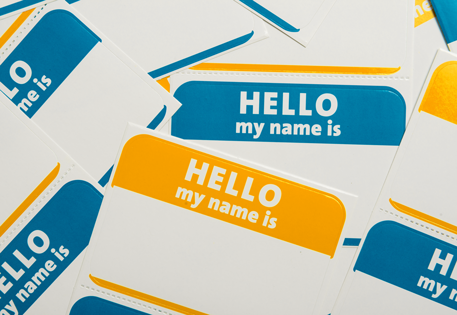How to... Name your brand
« Browse all tipsYou may be busy making all kinds of decisions to kick-start your business, but one of the most important (and mind-boggling) conundrums is what to name your company. Or perhaps you’ve already got a great company name, and now you’re pondering what to call your products and services. This is super important and is worth putting some real thought into. So, where to begin? There are lots of different ways to approach it; here are my tips for adopting a smooth process
Step 1 – Brainstorm
Get a bunch of people together in a room – six to eight is a good number to get a range of ideas. Start by explaining the unique selling point of your brand or product; what’s the most important thing you want your name to convey? How do you want people to feel when they hear it?
Then it’s time to get creative. Design a series of two or three minute exercises to generate as many names as quickly as possible. No name is a bad one at this stage; in fact you’ll sometimes find that the most intuitive names, without too much agonizing thought, are some of the best!
Let’s say your business is selling quirky fashion accessories and you’re launching a new tie with a velvet texture. You could of course simply call it the ‘Velvet Tie’ right? But what if you want something a little more emotive and playful to fit with the quirky nature of your brand? Start by asking your team to think about the texture. What does it feel like? (You’ll need to pass around a sample for inspiration).
Then ask them to create a list of words or phrases to describe the texture or quality (e.g. smooth, plush, soft to touch, velvety, silky, rich). Next up: task them with listing as many objects as possible that have a similar velvet quality (e.g. a peach or petal). With the pressure of time, you’ll be surprised at how many you can come up with.
Next, try to generate more names from your existing set of words by using these three naming techniques: ‘real-twisted’ words (turning a common word into a product name by adding a prefix or suffix – like ‘TouchX’), invented acronyms (like PIN, short for Personal Identification Number) and coined phrases (fusing two words together – like ‘EasyJet’). Look at each other’s lists for inspiration. By the end of the session, if it’s gone to plan, you should have 200+ ideas. If you’ve got the manpower, run another session with different people to get alternate perspectives.
Step 2 – Shortlisting
The next stage is to shortlist your options down to a list of top ten contenders. Think about what criteria the perfect name needs to meet. Concise is better than long and convoluted. Does it roll off the tongue, is it easy to pronounce, does it describe - or least give a sense of - what you do? It’s great to have a unique set of names, particularly when it comes to your brand, but if you’re naming a product, they shouldn’t be so off-the-wall that your customers haven’t got a clue as to what you’re selling.
Step 3 – Legal Checks
Once you’ve got your top ten, it’s time for due diligence. You need to check whether your name is protectable. Do any other companies in your industry have this name trademark registered? It’s advisable to work with a legal firm to conduct these checks, and costs will vary from company to company. However, if you don’t have the budget, it’s worth researching yourself, to see if anyone else has taken it. You can check for registrations on the Intellectual Property Office website ( USPTO for the US) and of course there’s always Google, but keep in mind that it’s not fool-proof and can be quite time consuming depending on how common your name is, but it’ll help weed out some of the more obvious ones.
Step 4 - Language Check
It’s good practice to run some language checks to ensure your names don’t mean something offensive or the opposite of what you’re intending in another language. This is particularly relevant if you ever plan to launch your business globally. Even if that feels like a lifetime away, it’s better to plan ahead for the possibility. Contact your friends and colleagues who speak foreign languages and ask them if your name has any negative associations. Remember, you’re not asking them if they ‘like’ it!
Step 5 – Testing, testing
You’ll probably lose around five names in the language and legal checks, so you should be left with a few final contenders. If there’s no clear winner (hopefully you love them all!), try testing them out for context. Write some dummy website copy, or imagine you’re announcing the product at a conference. Can you picture it? Does it sound right?
Step 6 – Protection
If it’s a unique name you should try to protect it to avoid other people using it in the future by filing an application to register a trademark. Approval can take some months, and you’ll have to part with some cash, but it’s worth it in order to establish a strong, distinctive brand.
Written by Natasha Berthiaume
New to MOO?
MOO makes life a little less virtual. We help our customers print things like business cards, postcards, flyers and stickers, making it easy for them to share information about themselves or their business in the real world.
Print is simple and wonderful. We love it.
View Our Products




